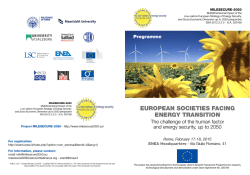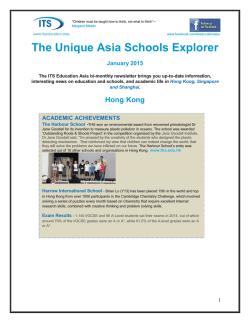
A Tale ofTeeming Cities - Get Homework Help at Homework
CHAPTER 2 A Tale of Teeming Cities "Tomorrow morning we will release our sales numbersfor the month ofNovember. This event is overshadowed by the tragic death ofjdimytai Damour at our Valley Stream, New York, store on November 28.... " --Statement from the president of the Northeast Division. Walman USA (December 3. 2008) Italy, France, United Kingdom, Germany, japan, and the United States. -Economies projected by Goldman Sachs to be overtaken by one or more of China. India. Russia. or Brazil before 2050 "From here on out, it's an urban world. " -Joel E. Cohen. Professor of Populations. Rockefeller Univcrsi;Y and Columbia University I t was one o'clock in the morning when Leana Lockley, twenty-eight years old and five months pregnant, lined up with her husband and two family members outside the Green Acres Mall Walmart store in Valley Stream, New York. Whining engines and lights pierced the night as jets came and went from nearby ]FK Airport. It was November 28, 2008, the day following Thanksgiving called "Black Friday," the busiest American shopping day of the year. The global economy was crashing, everyone was looking for bargains, and Walmart was cutting its prices for six hours only. By the time the store opened at five o'clock a.m. there were two thousand people crowded restlessly against the glass storefront, waiting to get in. The doors unlocked and people surged forward. Lockley was literally picked up off her feet and carried through the door opening. There were loud cracking noises as hinges broke off, and the sounds of crashing glass. An older woman fell. Lockley tried to pick her up but was knocked to her 30 THE WORLD IN 2050 knees. A large man saw her and tried to help. "He was facing the crowd, and he had his hands up, trying to push them back in order for me to escape," she later recounted on Fox News. "He was trying to block the people from pushing me to the ground and trampling me ... he was on his knees, I could look at him eye to eye, and he was trying to push them back and then the crowd pushed him down, and he fell on top of me.""" His body covering hers, hundreds of deal-hungry shoppers stomped and shoved over them and streamed into the store. Lockley and her unborn daughter survived, as did three other injured shoppers sent to area hospitals. But the man who saved her life, thirtyfour-year-old Jdimytai Damour, was killed. As paramedics attempted to resuscitate him, shoppers continued to jostle past; then became irate when officials announced the store was being closed. The only son of Haitian immigrants, Jdimytai Damour was a very large but gentle man who enjoyed watching football and talked about being a teacher one day. The reason he was there that morning was not to buy, but to work. Because of his size-he was six feet five inches tall and weighed 27 0 pounds-he had been assigned to the front door. But he wasn't a trained security officer. He was a temporary worker, a subcontractor, hired by Walmart to help them help us to consume more stuff during the busiest retail season of the year. Far less tragic-and certainly less arrention-grabbing-was a second, very profound event that also happened in 2008. Its exact timing will never be known, but at some instant during the year, the number of people living in urban areas grew to brie£ly match, for a few seconds, the number of people living in rural areas. Then, somewhere, a city baby was born. From that child forward, for the first time in our history, the human race became urban in its majority. For the first time ever, we have more people living in cities than out on the land. For the first time, most of us have no substantive ability to feed or water oUl'seives. We have become reliant upon technology, trade, and commerce to carry out these most primitive of functions. Sometime in 2008, the human species crossed the threshold toward becoming a different animal: an urban creature, geographically divorced from the natural world that still continues to feed and fuel us. A Tale of Teeming Cities 31 What does the awful death of Jdimytai Damour have to do with our transformation to an urban race? Aside from occurring in the same year, what connection may be drawn between these two events? From a macroeconomic perspective, the frenzied horde that killed poor Mr. Damour was, in its own mindless way, helping to build cities all over the world. Most of the items for sale in the Valley Stream Walmart were made overseas, by urban workers in the hundreds of Asian towns and cities churning out the cell phones, Bat-screen televisions, netbooks, and other essentials of twenty-first-century life. Cities around the world have participated in the process of getting those products onto Walmart's shelves. A global supply web was needed to transfer the raw materials and components to manufacturing hubs like Shenzhen, Dongguan, Guangzhou, and Bangalore. Then, the finished goods were sent to the United States, very likely in freighters and steel shipping containers built in places like Geoje (South Korea), Nagasaki Qapan), and Ningbo (China). These vessels were unloaded in the American ports of Long Beach or Los Angeles before being trucked east to Gloucester City, New Jersey, for redistribution. From there, they were trucked once again to Valley Stream, New York. Financial transactions between New York City and Hong Kong, as well as Chicago, Tokyo, London, Paris, Frankfurt, Singapore, and Seoul were taking place. So every time a new Bat-screen TV is sold by Walmart, urban agglomerations around the globe all win another little economic boost. These invisible ties across the globe hum, the economic wheels turn. Consumption fuels commerce, thus growing cities, further enlarging the overall consumer base. 45 The urban economy grows-as it must, to support its growing number of residents and the many services they now require. Salaries rise such that even menial entry-level jobs pay better than a farmworker's wages. The reason that the world's rural people are moving into cities is that they can make more money in town. This is partly because of the described growth of urban economies, and partly because demand for farm labor falls as agriculture commercializes, mechanizes, and becomes export-oriented. Worldwide employment in agriculture is falling fast and in 2006, for the first time ever, it was surpassed by employment in the services sector. 46 32 THE WORLD IN 2050 A Tale of Teeming Cities And because every new urban resident is also a new urban consumer, the cycle is self-reinforcing. More urbanites buy more electronics, services, and imported processed food, prepared and served to them by others. More 1975 Tokyo, Japan (26.6) New York-Newark, USA (15.9) Mexico City, Mexico (10.7) entry-level jobs for new migrants are created. More managerial posts are needed. Ladders rise and the urban economy growsY This urban shift is driving major demographic changes around the globe. City dwellers are projected to roughly double in number by 2050, rising from 3.3 billion in 2007 to 6.4 billion in 2050.48 However, the geography of this is not uniform. Urban majorities came to Europe and America decades ago, in the 1960s, 1950S, or even sooner. These places are already more than 70% urban today. This new trend is most dramatic in the developing world, especially Asia and Mrica, the most populous places on Earth. For the last two decades, cities in the developing world have been growing by about three million people per week. 49 That is equivalent to adding one more Seattle to the planet every day. Asia is only about 40% urban today~ but by 2050 that number will top 70% in China, with over one billion new city slickers in that country alone. Already, places like Chongqing, Xiamen, and Shenzhen are growing more than 10% annually. About 38% of Mricans live in cities today, but by 2050 more than half will. While Mrica will still be less urbanized than Europe or North America today, this is nonetheless a profound transformation. When combined with 2°°7 Tokyo, Japan (35-7) New York-Newark, USA (19.0) Mexico City, Mexico (19.0) Mumbai, India (19. 0 ) Sao Paulo, Brazil (18.8) Delhi, India (15.9) Shanghai, China (15. 0 ) Kolkata (Calcutta), India (14.8) Dhaka, Bangladesh (13.5) Buenos Aires, Argentina (12.8) Los Angeles-Long Beach-Santa Ana, USA (12.5) Karachi, Pakistan (12.1) Al-Qahirah (Cairo), Egypt (11.9) Rio de Janeiro, Brazil (11.7) Osaka-Kobe, Japan (n.3) Beijing, China (n.l) its fast population growth rate, this means that Mrica will triple the size of its cities over the next forty years. 50 At 1.2 billion people, Mrica will hold Manila, Philippines (II.I) nearly a quarter of the world's urban popuiationY Tucked away in the back ofa 2008 report by the United Nations Popula- Moskva (Moscow), Russia (10.5) Istanbul, Turkey (10.1) tion Division are some stunning data tables. 51 They rank our past, present, and future "megacities"-urban agglomerations with ten million inhabitants or more-for the years 1950, 1975, 2007, and 2025. The projections may surprise you: World Megacities ofTen Million or More (population in millions) 195° New York-Newark, USA (12.3) Tokyo, Japan (n.3) 202 5 Tokyo, Japan (36.4) Mumbai, India (26-4) Delhi, India (22.5) Dhaka, Bangladesh (22.0) Sao Paulo, Brazil (2I.4) Mexico City, Mexico (21.0) New York-Newark, USA (20.6) Kolkata (Calcutta), India (20.6) 33 34 A Tale of Teeming Cities THE WORLD IN 2050 Shanghai, China (19.4) Karachi, Pakistan (19.1) Kinshasa, Democratic Republic of the Congo (16.8) Lagos, Nigeria (15.8) Al-Qahirah (Cairo), Egypt (15.6) Manila, Philippines (14.8) Beijing, China (14.5) Buenos Alres, Argentina (13.8) Los Angeles-Long Beach-Santa Ana, USA (13.7) Rio de Janeiro, Brazil (13-4) Jakarta, Indonesia (12.4) Istanbul, Turkey (12.1) Guangzhou, Guangdong, China (n.8) Osaka-Kobe, Japan (1I.4) Moskva (Moscow), Russia (10.5) Lahore, Pakistan (10.5) Shenzhen, China (10.2) Chennai, India (10.1) Paris, France (10.0) The century of megacities has already begun. From just two in 1950 and three in 1975, we grew to nineteen by 2007 and expect to have twenty-seven by 2025. Furthermore, in sheer size alone our global urban culture is shifting east. Of the eight new megacities anticipated over the next fifteen years, five are in Asia, two in Africa, and just one in Europe. Zero new megacities are anticipated for the Americas. Instead, this massive urbanization is happening in some of our most populous countries: Bangladesh, China, India, Indonesia, Nigeria, and Pakistan. New York City was the world's secondlargest metropolis in 1977, when Liza Minnelli first sang the hit song "New York, New York" (later popularized by Frank Sinatra) to Robert De Niro in a Martin Scorsese movie. By 2050, the "City That Never Sleeps" will be struggling just to stay in the top ten. The story doesn't end with megacities. People are flocking to towns of all sizes, large and small. Indeed, some of the fastest growth is happening in urban centers with less than five hundred thousand people. According to 35 the United Nations model, the number of "large" cities-those with populations between five and ten million-will increase from thirty in 2007 to forty-eight by 2025. Three-quarters of these will be in developing countries. By 2050 Asia-the world's most populous continent and still dominated by farmers today-will be nearly as urbanized as Europe,53 What does all this mean for life in the countryside? The world's rural population is projected to peak somewhere around 3.5 billion in 2018 or 2019, then gradually fall to around 2.8 billion by 2050. Most of this rural depopulation will happen in the developing world, because OECD countries have now largely completed this shift. Take a drive through rural America. You'll find it littered with ghostly relics of formerly bustling farm towns. The developing world is repeating now-on a much grander scale-the same emptying out of rural regions that began in developed countries in the 1920S. Ifyou've been adding and subtracting these various numbers, then you've already realized that the rural population declines are too small to offset the urban increases. The world's total population of people will continue to grow substantially in the next half-century. We are now on a trajectory to add nearly 40% more population by the year 2050, raising our number to around 9.2 billion. 54 Who will we be in 2050? In that year, for everyone hundred of our future children and grandchildren born, fifty-seven will open their eyes in Asia and twenty-two in Africa, and mostly in cities. What Kind of Cities Will They Be? So the people of Earth are rushing into town. "The twenty-first century," declared the United Nations, "is the Century of the City."55 But what kind of cities will they be? Will they be prosperous or Dickensian? The best of times, or the worst? There is certainly reason for optimism. The economic downturn of 2008-09 notwithstanding, the long-term trends all point to continued economic globalization, rising urban wealth, and a host of new technologies to help make cities cleaner, safer, and more efficient. It seems plausible to imagine the ascendance of shining, modern, prosperous cities allover the world. Take, for example, the success story of Singapore. 36 THE WORLD IN 2050 A Tale a/Teeming Cities A port city situated on a large island at the southern tip of the Malay Peninsula, Singapore began as a British trading colony in 1819 and remained under colonial rule for one hundred and forty-one years before gaining independence in 1960. Since then, despite its small size (less than 270 square miles), few natural resources, and no domestic fossil fuel supply, Singapore's growth and economic success have been phenomenal. Between 1960 and 2005 Singapore's population grew rapidly, averaging 2.2% annually or doubling every thirty-six years. Once a calm British trad- 37 Singapore is a good example of how rapid population and economic growth, when properly managed, can grow a city that not only has a large economy but is also technologically advanced, culturally vibrant, and an enjoyable place to live. To borrow a name coined by my UCLA colleague Allen Scott,l9 it is a shining technopolis. Writes author Henri Ghesquiere about Singapore's success: Go ing outpost, Singapore today has nearly five million people and has become a throbbing services, technology, and financial hub for Southeast Asia. It Rapid growth was matched by enhanced well-being. The quality of life improved for large numbers of people. Singapore succeeded from the perspective of not only growth, but also social development.... China's is a global supplier of electronic components and runs the busiest port in the world, with over six hundred shipping lines. Despite having no oil to momentous decision in 1978 to reverse five centuries ofeconomic isolation was influenced in part by Deng Xiaoping's visit to Singapore that year. speak of, it is a major oil refining and distribution center. Singapore is also attracting major foreign investments in pharmaceuticals, medicine, and biotechnology. With a 2008 gross domestic product (GOP) of USD $192 His dream to "plant a thousand Singapores in China" sparked numerous delegations on study tours to the island. South Korea was impressed with Singapore's success in overcoming corruption. The city-state's mastery in billion, Singapore's economy is bigger than those of the far more populous keeping urban traffic flowing has fascinated officials from many countries, Philippines, Pakistan, and Egypt. Geopolitically, Singapore has become one of the most globalized, stable, and its housing program is studied by planners from around the world. Dubai eyes Singapore continually.... and prosperous countries in the world. Per capita income is over USD $50,000, higher than in the United States. It has a democratically elected Unfortunately, there is no rule saying a city must be a nice place to live government and ranks second in the world's Index of Economic Freedom. 1G It is a member of the IMF, WTO, UNESCO, Interpol, and many the performance of its sovereign in order to attract fast population and economic growth. Parks, good governance, and smoothly flowing traffic are optional, not required. Sometimes cities grow at an astonishing rate, despite being hell on Earth. wealth funds has been legendary. Through heavy global investments they've returned 4%-10% annually, growing a few humble millions into over USD Take Lagos, Nigeria. Like Singapore, Lagos is a coastal port city, is built on an island, and was once a British colony. It guards the mouth of a huge billion today'!? Singapore has learned to manage long-standing tensions between its main ethnic groups (Chinese, Malay, and Indian) and religions. Mass transit is abundant, clean, and energy-efficient. 18 There are wonderful parks, theaters, swampy lagoon and for centuries has been one of the most important trading ports of West Mrica. Over the years it has variously exported slaves, ivory, peppers, and, most recently, oil. Like Singapore, Lagos also won its independence from Great Britain in 1960. Both cities are located a few degrees north of the equator in moist, tropical climates. Both are governed by civilian democracies, although Nigeria's is still young and shaky after years of military rule. other global institutions. Since the 1970S $200 and museums. Singapore's health care is excellent and its life expectancies are the fourth-longest in the world (seventy-nine years for men and eighty-five years for women). Aggressive law enforcement-while also leading to complaints of excessive strictness and a sort of police-state authoritarianismhas made corruption, violent crime, and the trafficking of sex and drugs virtually nonexistent. Since independence, Lagos' population has grown even faster than Singapore's-averaging about 5% annually since 1960. Between 2000 and 2010 its population grew almost 50%, from 7.2 to 10.6 million people. 38 THE WORLD IN 2050 A Tale of Teeming Cities 39 Nigerians are pouring in from the surrounding countryside and villages per hundred have piped water, mOSt instead rely on shared outdoor taps because there is money to be made in Lagos. The city has now run out of ~oom, filling up its island and spilling across congested bridges to penetrate or wells. Nearly all water sources are regularly contaminated with E coli, streptococcus, and salmonella. Unsurprisingly, disease is rampant, including more than fifteen miles inland. By the year 2025, Lagos is projected to grow another 50% to sixteen million people, making it the twelfth-largest city in the world. With a 2007 gross domestic product of about USD $220 billion-bigger even than Singapore's-Lagos is the economic epicenter typhoid fever, yellow fever, Lassa fever, malaria, leptospirosis, shistosomiasis, hepatitis, meningococcal meningitis, HIV/AIDS, and the H5Nl avian flu. Human life expectancies are just forty-six years for men and forty-seven for women. of Nigeria and indeed of the entire western African continent. Similarities between the two cities end there. Unlike Singapore, Lagos has It gets worse. Two-fifths of the people living in Lagos are victimized by corruption, especially demands for bribes from their public officials. 6' not handled its growing pains well. It is an overcrowded dystopia of traffic jams, squalor, corruption, murder, and disease. Per capita income averages around USD $2,200 per year. Millions live in boats without electricity or Robberies, assaults, and murders are a constant fact of life. Failed by their police and judiciary, citizens form vigilante militias with names like the "Bakassi Boys," who fight back at criminals with machetes and shotguns. 63 sanitation. Four out of ten women cannot read. Police are outnumbered, When government officials perceive disorder, they issue orders to shoot on ineffective, and unpredictably dangerous. The physical infrastru~ture is simply overwhelmed. Writes the urban geographer Matthew Gandy:61 sight. In general, police and soldiers are best avoided in Nigeria, as it is not uncommon for police officers to simply shoot potential suspects rather than The sprawling city now extends far beyond its original lagoon setting to arrest them. Nigeria's National Human Rights Commission, a domestic agency charged with monitoring the country's human rights violations, encompass a vast expanse of mostly low-rise developments including as many as 200 different slums.... Over the past 20 years, the city has lost recently compiled a heartbreakingly long list of abuses, including the following three incidents: 64 much ofits meet lighting, its dilapidated road system has become extremely congested, there are no longer regular refuse collections, violent crime has become a determining feature of everyday life and many symbols of civic culture such as libraries and cinemas have largely disappeared. The city's sewerage network is practically non-existent and at least two-thirds of childhood disease is attributable to inadequate access to safe drinking water. In heavy rains, over half of tl1e city's dwellings suffer from routine flooding and a third ofhouseholds must contend with knee-deep water within their [March 2, 2005] "A commercial bus with registration number, XA 344 plying the NorthBank to Wadata route was stopped by Police Constable (PC) Vincent Achuku, and without searching the bus, he demanded (money) bribe from the driver, Godwin Anuka. The driver pleaded with PC Achuku to let him continue with his journey and that he would pay on his return trip. This infuriated PC Achuku and he immediately cocked his service rifle, shot and killed the driver." homes. [July 28, 2006] "In the early hours ofJuly 28, 2006, officers of the Special The flooding observed by Dr. Gandy is a serious problem. Lagos'. extreme growth has pushed development, much ofit slum, into the city's last remain- AntiRobbery squad ... went to the compound ofAdulkadir Azeez, 70 years old, where he lives with his extended family.... The sound of a gunshot ing real estate: swampy, low-lying swales that are barely above sea level. Human excrement flows in open ditches. Drainage is so bad that when woke him up and he went out to find out the cause. Immediately he stepped out of his house, he was shot dead. The policemen then went to his son's it rains, the waste floats into people's homes. Fewer than fifteen people house (Ibral1im Abdulkadir), forced open the door and shot him dead too. 40 THE WORLD IN 2050 The second son of the old man, Shehu Abdulkadir, heard the gunshots, opened his door and saw his father lying dead on the ground. He tried to find out what happened and was also shot dead by the policemen." [September 15, 2006] "On Friday, September 15, 2006, at about 3.00 P.M., a team of over 200 policemen in eight trucks from Delta State Police Command drove to Ahesere Community.... On arrival, they started shooting sporadically. According to media reports villagers including women and children took to their heels to avoid the bullets of the rampaging policemen. Those that could not escape were shot and killed or wounded. The policemen then looted several shops and homes before setting them ablaze. When the policemen eventually retreated around 5.30 P.M. 22 persons lay dead, 60 houses and 15 vehicles were burnt. The police also set ablaze two corpses while some were taken away and dumped in the bush. Five other victims, mostly elderly persons also reportedly died from shock over the incident." While all is not lost in Nigeria-it completed its first transfer of power between civilian governments peacefully in 200.7, and Lagos crime rates fell sharply in 2009-it remains a dangerous place to live. Despite growing Nigeria's gross domestic product to the second largest on the Mrican continent, Lagos is a slum city and-like other slum cities in Mrica, Asia, and Latin America-is a stark illustration ofan urban world we don't want. Clearly, there is far more to building shining technopolises than urbanization and economic growth. Sub-Saharan Mrica is a collection of countries bursting with natural and agricultural resources. Many have functioning or semifunctioning democracies. Yet, colonialism, nonsensical borders, tribal loyalties, HIY; and other problems have bogged it in muddy poverty. Nearly two-thirds of its towns and cities are slums. Recall that at current growth trajectories, these urban populations will triple in the next forty years. The still-unfolding results of the Lagos experiment do not bode well for this new Mrican urbanism. Under the conservative ground rules of our thought experiment, it's hard to envision how so many problems can be eliminated overnight. By 2°50 I imagine much of sub-Saharan Mrica-the cradle of our species-to be a dilapidated, crowded, and dangerous place. A TaLe of Teeming Cities 41 Shifting Economic Power Not only is the geography of the world's urban population shifting, so also is its wealth. The economic impact of nearly two billion new urban consumers in Asia has not gone unexamined by economists. Unlike the situation in Mrica, there is every indication that the rising Asian cities will be modern, globalized, and prosperous. In a thoughtful, forward-looking assessment the U.S. National Intelligence Council writes:65 The international system-as constructed following the Second World War-will be almost unrecognizable by 2025.... The transformation is being fueled by a globalizing economy, marked by an historic shift of relative wealth and economic power from West to East, and by the increasing weight of new players-especially China and India. China and India-along with Brazil and Russia-are considered such economic giants-in-waiting that they've won their own acronym, the "BRICs" (from the first letters of Brazil, Russia, India, and China), first coined in 2003 by the global financial services company Goldman Sachs.66 According to econometric model projections by Goldman Sachs, PricewaterhouseCoopers, the Japan Center for Economic Research, the International Monetary Fund, and others, the BRICs are on pace to displace current economic leaders faster than you might think, thus redrawing the map of global economic power over the next forty years.67 The world's three biggest economies today are the United States, Japan, and Germany. But by 2050 most model projections have China and India leaving all other countries save the United States in the dust. The Goldman Sachs model, for example, projects U.S. gross domestic product to rise from USD $10.1 to $35-1 trillion, Japan's from $4.4 to $6.7 trillion, and Germany's from $1.9 to $3.6 trillion by then. In contrast, India's GDP is projected to rise from $0·5 to $27·8 trillion and China's from $1.4 to a whopping $44.4 trillion. Brazil and Russia are projected to rise from $0.5 to $6.1 trillion and $0·4 to $5·9 trillion GDp, respectively.68 China would thus overtake the United States as the world's largest economy and India would become the third largest. 42 THE WORLD IN 2050 The 2008-09 global financial crisis only reaffirmed this picture. While the economies ofAmerica, Japan, and Germany were shrinking, the economies of Brazil, India, and China grew 2%,6%, and 9% annually, respectively.69 By late 2009 Brazil, one of the last countries in and first out of the downturn, was again growing 5% per year and was on pace to become the world's fifthlargest economy even sooner than Goldman Sachs envisioned, overtaking Britain and France sometime after 2014.?0 New post-crisis modeling by the Carnegie Endowment for International Peace reaffirmed that China's GDP would indeed surpass that of the United States, probably by 2032. By 2050 the world's three largest economies would still be China ($45.6 trillion), the United States ($38.6 trillion), and India ($17.8 trillion).?1 While such growth rates sound dramatic, they are actually less spectacular than those enjoyed by Japan for three decades between 1955 and 1985. If these economic model projections hold-and in accordance with our "The Models Are Good Enough" ground rule let's assume here that they willthe world will move from having not one huge economy but three. Of the original top three, only the United States will remain, in distant second place behind China. The relative clout of deposed Japan, Germany, and others of the original G6 (France, Italy, and the United Kingdom) on the world stage will be diminished. So if China and India are poised to dethrone the original G6 economies, what does that mean for you? Will Chinese and Indians soon enjoy more lavish lifestyles than Germans and Italians? Will Parisians emigrate to Sao Paulo, seeking better pay and a happier future for their children? Almost certainly not. Recall that one of the big drivers of all this economic growth is rising urban population and modernization. The economies of China and India must grow to support that. If they didn't, per capita incomes would decrease. The cost of living would have to go down, not up. That's not how things work. Can you imagine all those rural migrants pouring into New York City in the early 1900S driving the price of food and housing down? No. Asia's rising cities demand that the economies of China and India grow many times over, and this will also multiply per capita incomes in these countries. However, that progress in personal wealth will still be relative to the extremely low per capita incomes of today (averaging less than $3,000 A Tale of Teeming Cities 43 per year for both ~ountries in 2010). With the sole exception of Russia,?' personal incomes in BRIC countries are not expected to surpass those of France, Germany, Italy, Japan, the United Kingdom, or the United States by 2050. An average Indian today makes less than one-thirtieth the income ofan average Brit. In 2050 she or he will make less than one-third.7J That's a tenfold improvement, to be sure, but still a yawning divide. The Goldman Sachs model, for example, projects that the average Chinese worker will earn around USD $31,000 per year in 2050. That is much better than in 20IO ($2,200 per year) but still substantially below the projected 2050 per capita incomes for Italy ($41,000), Germany ($49,000), France ($5 2,000), the United Kingdom ($59,000), Japan ($67,000), and the United States ($83,000). At the national geopolitical level, however, new superpowers mean complicated, shifting alliances. Having more superpowers portends intense strategic rivalries for trade, foreign investment, and natural resources. It means having more powerful political leaders in the world, and history tells us that their ideas matter. The choices made by Vladimir Lenin, Joseph Stalin, Adolf Hitler, Mao Zedong, Winston Churchill, Franklin D. Roosevelt, Harry Truman, and George W Bush will reverberate for years. Running through everything are the fault zones ofhistorical, cultural, and religious divisions. "Bad outcomes are not inevitable," the National Intelligence Council assessment concludes, but "today's trends appear to be heading toward a potentially more fragmented and conflicted world."71 The choices of future political leaders cannot possibly be divined here. But what we can foresee is an assortment of growing demographic, economic, and resource pressures that will shape the context and options available to them. We are barreling toward a world with nearly 40% more people and a doubled food requirement by 2050. We are transforming from a poor rural to wealthier urban species. We are in the midst of a historic transfer of money and power from West to East. The bad news, as we saw in Lagos, is that some parts of our world are poorly equipped to deal with these changes. The good news is that in our rush to urbanize, we may have found the golden pliers for defusing Ehrlich's population bomb. 44 THE WORLD IN 2050 A Tale o/Teeming Cities I See Old People 1. High and similar rates of birth and death (e.g., the preindustrial era, with a small and relatively stable total human population); followed by These megatrends have personal consequences. Honestly, for the long haul, I've begun socking away shares of pharmaceutical company stock. Because beginning right about now, the world is starting to fill up with 2. old people. Demography just might be the most fascinating academic subject you've 3· Falling births (still exploding, but decelerating); and finally never studied. Underneath its dull name and dry statistics lie gripping stories of sex and death, of the rise and fall of communities, of why migrants choose to pick up and move, of the futures for our retirements and for our children. It uncovers big surprises like the myth of the American melting pot,?l Although combing through census and national registry databanks on numbers of births, deaths, and marriages may not sound very fun, a new world is revealed. These data comprise a road map of our future still wired into today. Consider the "baby boomer" phenomenon-that is, the post-World War II baby boom. Like a snake swallowing a big meal, this age bulge has worked its way through the decades, triggering all manner ofeconomic and cultural transformations along the way. Many of them-like demand for doctors, vacation getaways, and Viagra as the boomers now enter their sixties-have been anticipated for years. Like all baby booms, it had a softer "baby echo" that cropped up a generation later-again, predictable. . "Population momentum" is another example ofhow demographIC futures can be foreseen. Even if a society's average fertility rate7 6 suddenly falls, its population will continue to grow twenty years la~~r owing to the ~bu~~an~e of new parents carried forward from when fertlhty rates were high. This works in the other direction, too, meaning that elderly countries will keep shrinking even iffertility rises, owing to a small cohort of parents born when fertility rates were still low. The unprecedented explosion of people on Earth happened because births began outnumbering deaths, but there's more to it than that. The "Demographic Transition" concept described in Chapter I emerged from what transpired in Europe and the United States. And it appears to now be unfolding in the rest of the world as well. Recall that the Demographic Transition has four stages: 45 Falling deaths but not births (initiating a population explosion); followed by 4· Low and similar rates of birth and death (population stabilization at a new, higher total number). Most OECD countries have now passed through these stages and-except for those allowing high levels of immigration like the United States-have stabilizing or even falling populations. Most developing nations, however, are still in Stage 2 or early Stage 3. Thus, our run-up in global population is still under way. Once a population enters Stage 3 its net rate of growth starts to slow, and this has generally been happening, beginning at different times and to varying degrees, for most of the world. On average, growth rates in developing countries have decreased from around +2.3% per year in 195 0 to +1.8% 200 in 7. Expressed as "doubling times" (the number of years needed for a population to double), that means we have slowed from doubling our developing world population about every thirty years in 1950 to every forty years in 2007. As we saw in Chapter I, urbanization, modernization, and the empowerment ofwomen push fertility rates downward, thus ushering in the final stage of the Demographic Transition. Put another way, the urbanization of society-ifalso associated with modernization and women's rights-helps slow tile rate ofgrowth. There are, ofcourse, exceptions to this tendency, but as these phenomena continue to expand throughout the developing world, the global population explosion so feared by Thomas Malthus and Paul Ehrlich is expected to decelerate. Already, in late-stage, low-immigration developed COuntries like Japan and Italy, and in regions like Eastern Europe, populations have not only stabilized but are falling. Assuming that fertility rates continue to drop as they are now, we are heading toward a total world population of around 9. 2 billion in 2050, at which point we will still be growing but about half as fast as we are today,?8 46 THE WORLD IN 2050 One of the most profound long-term effects of women having fewer babies is to skew societal age structures toward the elderly (the pulse of babies from population momentum is only temporary). That is precisely what has now begun, in varying stages, all around the world (improving health care, of course, also extends our life spans, thus increasing the proportion of elderly even more). Demographers agree that we are racing forward to not only a more urban world, but a grayer one. This, too, is unprecedented in the history ofhumankind. For 99.9% of the time we humans have existed on Earth, our average life expectancy was 30 years or less. Archaeologists have never dug up the prehistoric remains of anyone over 50,79 This aging will hit some places faster and harder than others. With a median age of 44.6 years SO Japan is the world's most elderly country today. In contrast, the median age in Pakistan is just 22.1 years, almost half that ofJapan. Pakistan is youthful; Japan is full of geezers. But both places will become grayer during the next forty years. By 2050 the median Pakistani age will rise twelve years to 34. Japan's will rise another decade to 55. When I was young I remember seeing magazine advertisements targeting people who planned to retire at 55. In forty years fully half ofall Japanese will be at least that old. On the following page, a table shows how the graying trend will transpire for a few other countries over the next forty years. Sl As seen plainly on this table from just sixteen examples, there are large age contrasts around the world today and even larger ones emerging in the future. Korea, Russia, and China will join Japan as the world's great geri. atric nations. Mexicans will be older than Americans. Median ages will be higher everywhere, but Korea, Vietnam, Mexico, and Iran will age radically, by fifteen years or more. Only our poorest, least-developed countries-like Afghanistan, Somalia, and the Democratic Republic of Congo-will still have youthful populations in 2050; and even they will be somewhat older than today. This patchwork of wildly contrasting age patterns around the globe is especially driven by the timing of fertility transitions-when the baby booms and echoes happened, and most importantly, when fertility rates first began to fall. s, In many OECD countries this began in the late 1950S, so the graying process is nearing its end. Median ages have already become quite high today and by 2050 will average only six years older. The same process A TaLe of Teeming Cities Some World Aging Patterns by 2050 (median age, in years) Country Republic of Korea Russian Federation China Germany United Kingdom Mexico Chile Vietnam USA Iran Brnil Argentina India Saudi Arabia Iraq Mghanistan 2010 20 50 Change .3 8.0 54·9 (+17 years) 37·9 45-3 45. 0 (+7 years) (+10 years) 44·9 (+1 year) 34·9 44. 2 40.0 43·4 (+3 years) 27·5 32.1 43·1 43. 1 (+16 years) (+II years) 26·9 36 .5 41.6 (+15 years) 41.1 (+5 years) 25·9 40.6 (+15 years) 28·5 30.2 40 .4 (+12 years) (+10 years) 25·0 4 0 .3 38.6 (+14 years) 24·4 36.0 (+12 years) 19·6 31.1 (+12 years) 16·7 23·0 (+6 years) (Sourct: United Nations Population Division) ~s now under way in developing countries, where fertility drops beginning the 1960s, 1970s, and 1980s will unleash successive waves of aging over the planet for the next forty years. In In his 1982 film Blade Runner, director Ridley Scott imagined that my home city of Los Angeles would be filled up with Japanese people by the year 2019. In light of Japan's economic might at the time, it's not hard to see where the idea came from. But Mr. Scott should have consulted a demographer, because I just don't see where all those Japanese settlers will come from. Over the next forty years, Japan is going to lose about 20% of her population. Is an elderly population a good thing or bad? Clearly, there are some benefits: perhaps a wiser, less violent society, for example. But it also strains health care systems,8) and from an economic perspective it absolutely raises 47 48 THE WORLD IN 2050 the burden on younger workers. Economists stare hard at something called the "elderly dependency ratio," usually calculated as the percentage ofpeople aged sixty-five or older relative to those of "working age," between fifteen and sixty-four. 8i By the year 2050, elderly dependency ratios will be higher all around the world. Some places, like Korea, Spain, and Italy, will have elderly dependency ratios exceeding 60%. That's barely sixteen people of working age for every ten elders. Japan, with a dependency ratio of 74%, will have only thirteen. Elsewhere, the overall dependency ratio will be lower but the transition shock greater. Relative to 2010, dependency ratios will more than quadruple in Iran, Singapore, and Korea. They will more than triple in China, Mexico, Brazil, Cuba, Turkey, Algeria, Thailand, Vietnam, Indonesia, and Saudi Arabia. Many of these places today have large youthful workforces that attract global business in its tireless search for labor. But by 2050, the United States may find itself in the unfamiliar position of being unable to find enough migrant farm laborers from Mexico's aging workforce. Clearly, the whole concept of "retirement" is about to undergo a major overhaul. People will have to work later in life, at least part-time, and perhaps as long as they are able. This is not necessarily a bad thing, as there is some evidence that most people are actually happier with a phased retirement 8S just so long as they perceive a sense of choice in the matter. 86 On the other hand, a "gray crime wave" has now begun in Japan: Arrests of struggling pensioners over age sixty-five has doubled-mostly for shoplifting and pickpocketing-and the number incarcerated has tripled to over 10% of]apan's prison population. 87 It is also apparent that some big cultural shifts will be needed in the way we treat and value our elderly. "Our society must learn that ageing and youth should be valued equally," writes Leonard Hayflick of the UCSF School ofMedicine, "iffor no other reason than the youth in developed countries have an excellent chance of experiencing the phenomenon that they may now hold in such low esteem."88 Another thing about to undergo a major overhaul is how the countries treat and value foreign immigrants. As the world grays, skilled young people will become an increasingly coveted resource, both for direct immigration and for globalized labor pools abroad. This creates the opportunity for new economic tigers to emerge when today's "youth bulges" mature into "worker A Tale afTeeming Cities 49 bulges" in Turkey, Lebanon, Iran, Morocco, Algeria, Tunisia, Colombia, Costa Rica, Chile, Vietnam, Indonesia, and Malaysia-countries offering a reasonably educated workforce and business-friendly environment. 89 A graying world also bodes well for women's employment in places that currently discourage it, because allowing women into the labor pool is the quickest and easiest way to double it. Countries where women don't work for religious and/or cultural reasons will experience an increasingly powerful economic incentive to abandon that tradition by 2050. The following point will become particularly important later in this book. In an aging world, those countries best able to attract skilled foreign workers will fare best. The early signs of a migrant planet are already here. In 2008, some two hundred million peOple-3% of the world population-were living outside their native countries. In most OECD countries the proportion of foreign-born was over 10%, even in countries like Greece and Ireland, where emigrants used to flow out, not in. 90 Foreign workers benefit their homelands as well as host economies: The World Bank estimates overseas remittances to poor countries was USD $283 billion in 2008, constituting a huge share of GDP in countries like Tajikistan (46%), Moldova (38%), and Lebanon (24%). What about in 2050, when the nursing homes in Mexico, China, and Iran are packed full? Who will be running the computers and caring for the residents? Unless the entire world has entered a full-blown robotic age by then, we will still need young people around to do things. Where on Earth will they come from? This is harder to project demographically, because those young people haven't been born yet. But based on current population structures, the most youthful countries in 2050 will be the same ones where fertility rates are highest today-in the world's least modernized places. Somalia, Mghanistan, Yemen, the West Bank and Gaza, Ethiopia, and much ofsub-Saharan Mrica will offer our world's youth in 2050. It's a critical but open question whether our poorest countries can convert their forthcoming demographic advantages into the new skilled workforces needed to help care for an elderly world. Just having a bunch ofyoung people running around is not enough. Huge improvements in education, governance, and security are also required. Women will have to start attending 50 THE WORLD IN 2050 school and working in places where this is uncommon today. Terrorism must be sufficiently quelled such that the countries that need young workers will accept immigrants from the countries that have them. I hope that these things can be achieved, and a global skilled-worker program all worked out, by 2050. I'll be eighty-two years old-and I just can't imagine anything lonelier than being turned over in my bed by a robot.
© Copyright 2025








